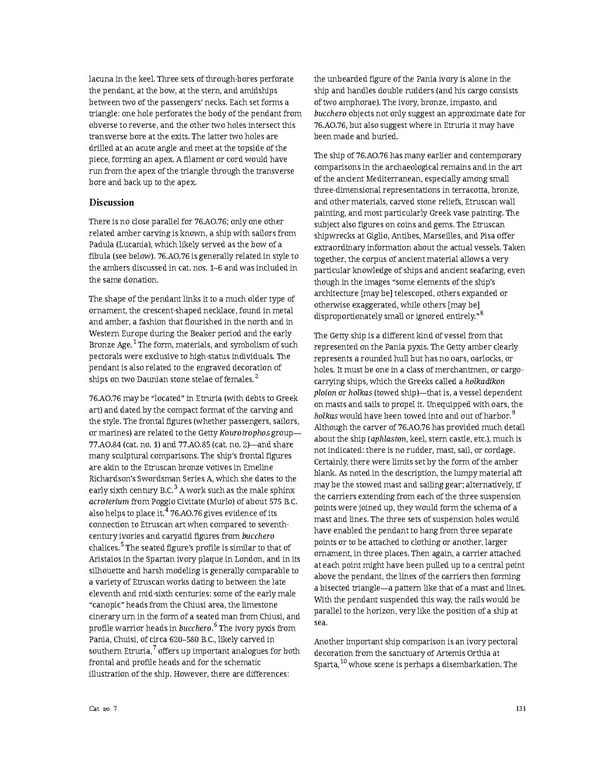lacuna in the keel. Three sets of through-bores perforate the unbearded figure of the Pania ivory is alone in the the pendant, at the bow, at the stern, and amidships ship and handles double rudders (and his cargo consists between two of the passengers’ necks. Each set forms a of two amphorae). The ivory, bronze, impasto, and triangle: one hole perforates the body of the pendant from buccheroobjects not only suggest an approximate date for obverse to reverse, and the other two holes intersect this 76.AO.76, but also suggest where in Etruria it may have transverse bore at the exits. The latter two holes are been made and buried. drilled at an acute angle and meet at the topside of the piece, forming an apex. A filament or cord would have The ship of 76.AO.76 has many earlier and contemporary run from the apex of the triangle through the transverse comparisons in the archaeological remains and in the art bore and back up to the apex. of the ancient Mediterranean, especially among small three-dimensional representations in terracotta, bronze, Discussion and other materials, carved stone reliefs, Etruscan wall painting, and most particularly Greek vase painting. The There is no close parallel for 76.AO.76; only one other subject also figures on coins and gems. The Etruscan related amber carving is known, a ship with sailors from shipwrecks at Giglio, Antibes, Marseilles, and Pisa offer Padula (Lucania), which likely served as the bow of a extraordinary information about the actual vessels. Taken fibula (see below). 76.AO.76 is generally related in style to together, the corpus of ancient material allows a very the ambers discussed in cat. nos. 1–6 and was included in particular knowledge of ships and ancient seafaring, even the same donation. though in the images “some elements of the ship’s The shape of the pendant links it to a much older type of architecture [may be] telescoped, others expanded or ornament, the crescent-shaped necklace, found in metal otherwise exaggerated, while others [may be] disproportionately small or ignored entirely.”8 and amber, a fashion that flourished in the north and in Western Europe during the Beaker period and the early The Getty ship is a different kind of vessel from that Bronze Age.1 The form, materials, and symbolism of such represented on the Pania pyxis. The Getty amber clearly pectorals were exclusive to high-status individuals. The represents a rounded hull but has no oars, oarlocks, or pendant is also related to the engraved decoration of holes. It must be one in a class of merchantmen, or cargo- ships on two Daunian stone stelae of females.2 carrying ships, which the Greeks called a holkadikon 76.AO.76 may be “located” in Etruria (with debts to Greek ploion or holkas (towed ship)—that is, a vessel dependent art) and dated by the compact format of the carving and on masts and sails to propel it. Unequipped with oars, the holkas would have been towed into and out of harbor.9 the style. The frontal figures (whether passengers, sailors, Although the carver of 76.AO.76 has provided much detail or marines) are related to the Getty Kourotrophos group— about the ship (aphlaston, keel, stern castle, etc.), much is 77.AO.84(cat. no. 1) and 77.AO.85 (cat. no. 2)—and share not indicated: there is no rudder, mast, sail, or cordage. many sculptural comparisons. The ship’s frontal figures Certainly, there were limits set by the form of the amber are akin to the Etruscan bronze votives in Emeline blank. As noted in the description, the lumpy material aft Richardson’s Swordsman Series A, which she dates to the may be the stowed mast and sailing gear; alternatively, if early sixth century B.C.3 A work such as the male sphinx acroterium from Poggio Civitate (Murlo) of about 575 B.C. the carriers extending from each of the three suspension also helps to place it.4 76.AO.76 gives evidence of its points were joined up, they would form the schema of a connection to Etruscan art when compared to seventh- mast and lines. The three sets of suspension holes would century ivories and caryatid figures from bucchero have enabled the pendant to hang from three separate chalices.5 The seated figure’s profile is similar to that of points or to be attached to clothing or another, larger Aristaios in the Spartan ivory plaque in London, and in its ornament, in three places. Then again, a carrier attached silhouette and harsh modeling is generally comparable to at each point might have been pulled up to a central point a variety of Etruscan works dating to between the late above the pendant, the lines of the carriers then forming eleventh and mid-sixth centuries: some of the early male a bisected triangle—a pattern like that of a mast and lines. “canopic” heads from the Chiusi area, the limestone With the pendant suspended this way, the rails would be cinerary urn in the form of a seated man from Chiusi, and parallel to the horizon, very like the position of a ship at profile warrior heads in bucchero.6 The ivory pyxis from sea. Pania, Chuisi, of circa 620–580 B.C., likely carved in Another important ship comparison is an ivory pectoral southern Etruria,7 offers up important analogues for both decoration from the sanctuary of Artemis Orthia at frontal and profile heads and for the schematic Sparta,10 whose scene is perhaps a disembarkation. The illustration of the ship. However, there are differences: Cat. no. 7 131
 Ancient Carved Ambers in the J. Paul Getty Museum Page 140 Page 142
Ancient Carved Ambers in the J. Paul Getty Museum Page 140 Page 142